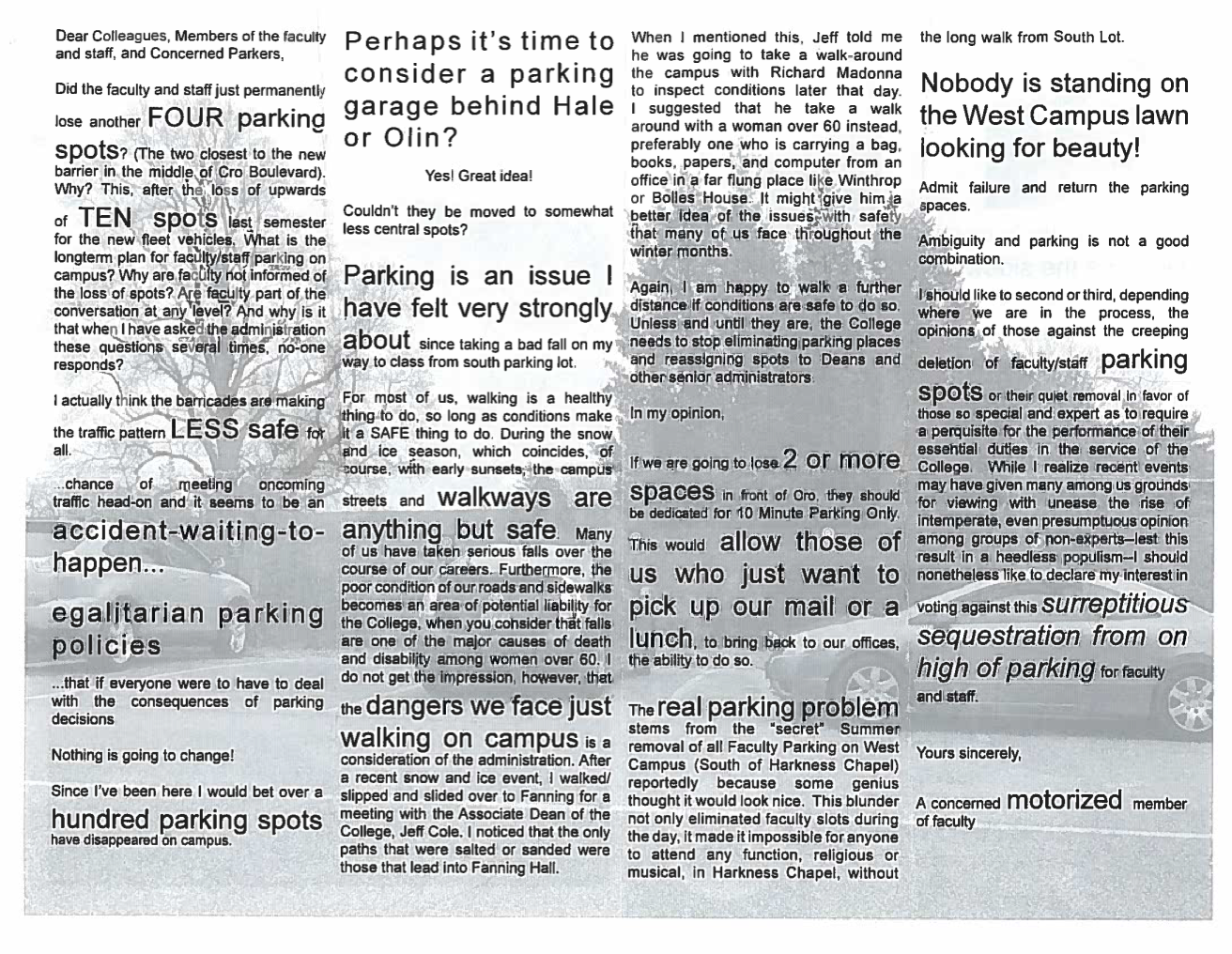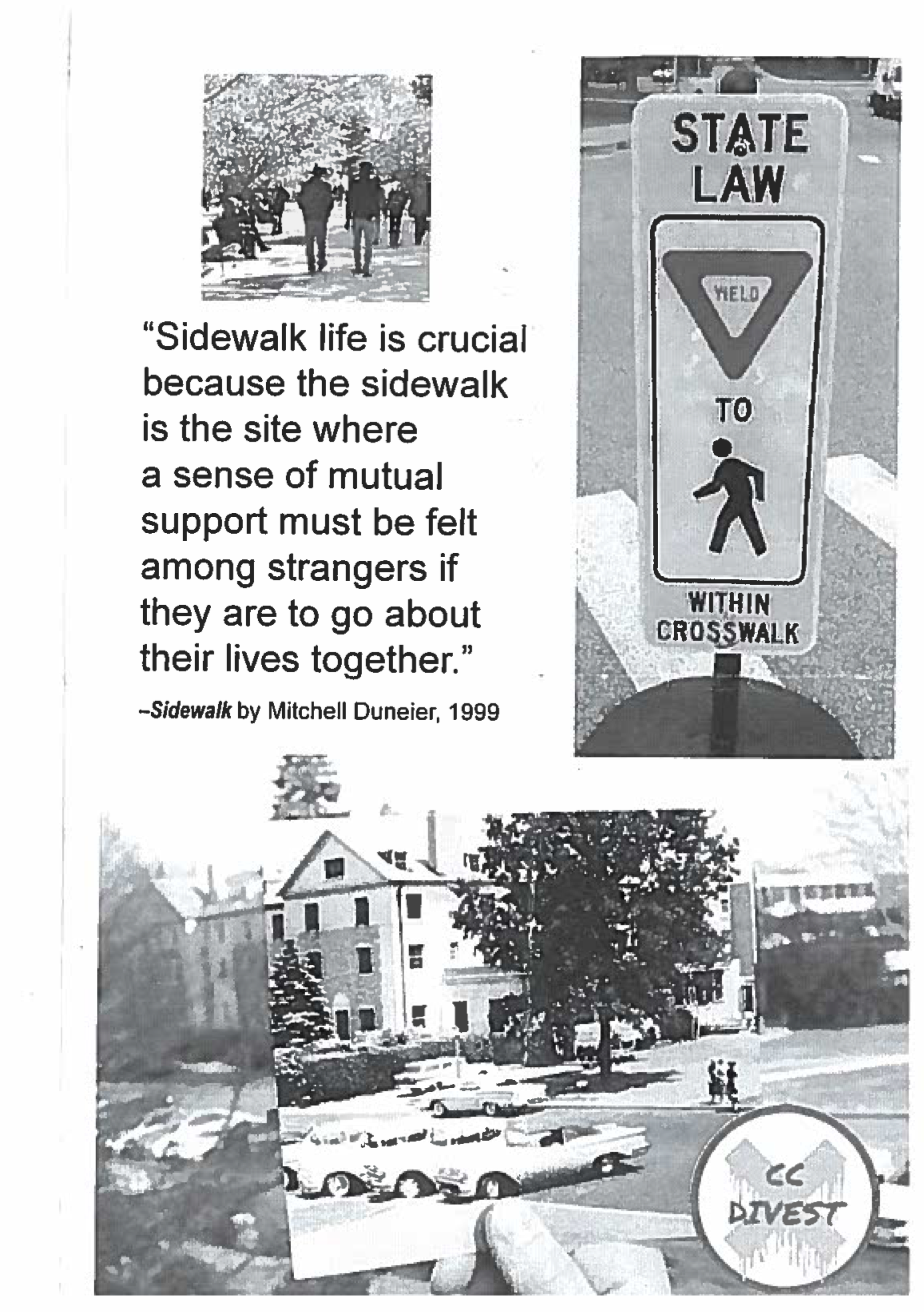With the exception of in-class and in-office laments, faculty concerns tend to be obfuscated from students by a separation of networks, but recently, a public, anonymous and tangible declaration of dissent popped up on campus and disrupted typical modes of communication. Allegedly authored by a member of the faculty, the communication appeared as a pamphlet titled “Speaking of Parking,” and it reminds us that changing parking regulations do not only affect students.
“Speaking of Parking” materialized about two weeks ago, on a rainy Tuesday. Upon dashing into Blaustein soaking wet, I saw a few of the pamphlets sitting on top of a stand for The College Voice. At first annoyed, I dripped water onto the stack of newspapers of my own production to select a pamphlet, and as soon as I had it, my annoyance was quelled. Someone on this campus had done something interesting.
The pamphlet is simple yet deliberate: a single piece of printer paper folded in half, with black-and-white photos of Conn parking areas on the exterior and a frustrated open letter on the inside. The writer of the letter seems more exasperated than irate, opening with a question: “Did the faculty and staff just permanently lose another FOUR parking spots?” It proceeds, with erratic variations in font size and spacing, to highlight a series of changes largely unknown to the student body, including “the loss of upwards of TEN SPOTS last semester for the new fleet of vehicles,” the estimation: “Since I’ve been here I would bet over a hundred parking spots have disappeared on campus,” and the declaration: “The real parking problem stems from the ‘secret’ Summer removal of all Faculty Parking on West Campus (South of Harkness Chapel) reportedly because some genius thought it would look nice.”
“Speaking of Parking” mixes frustration with sarcasm, and no singular member of the faculty or staff, to my knowledge, has laid claim to its authorship. It is signed, “Yours sincerely, A concerned motorized member of the faculty,” and a few clues might point us toward its author: the note about one hundred-plus spots indicates longevity, and an anecdote tells us that the writer probably does not work in Fanning: “I walked/slipped and slided over to Fanning for a meeting with the Associate Dean of the College, Jeff Cole. I noticed that the only paths that were salted were those that lead into Fanning Hall.” Twice the writer mentions “women over 60” as a group whose safety should be of concern, though I can’t say that this indicates authorship by a member of that demographic.

From “Speaking of Parking” arise questions beyond the mere identification of the author, most interestingly for me: why did it assume this form? The “concerned motorized member of the faculty” voices two concrete suggestions: “Perhaps it’s time to consider a parking garage behind Hale or Olin?” and that spaces in front of Cro, if lost as permanent faculty/staff parking, “should be dedicated for 10 Minute Parking Only,” allowing faculty and staff to stop briefly in the College Center. But rather than propose these ideas in a meeting, or send them to the faculty listserv, this person chose to remain anonymous when announcing: “I should nonetheless like to declare my interest in voting against this surreptitious sequestration…of parking for faculty and staff.”
Does the writer intend to avoid an electronic record? Have they presented their thoughts before and been ignored? Was this even written by a member of the faculty? The choice in format demonstrates a lack of faith in current systems of communication.
Upon closing the pamphlet and examining the back, readers find a quotation from the 1999 book Sidewalk by Mitchell Duneier, which says, “Sidewalk life is crucial because the sidewalk is the site where a sense of mutual support must be felt among strangers if they are to go about their lives together.” A quick Google search reveals that Duneier is a sociologist at Princeton University, and Sidewalk is a nonfiction study of a group of men living in Greenwich Village.
A second interesting back-panel feature is more locally rooted: the well-known CC Divest logo stamped in the bottom-right hand corner. According to Lauren Baretta ’18, student representatives of CC Divest claim no affiliation with the pamphlet, and note that its writer used the logo without their consent. To me, it appears to be a show of support for the cause, though the true purpose of the logo’s placement is unclear.
While administrative efforts have theoretically aimed to improve the parking situation on campus, parking will probably continue to inspire complaints among the Conn community. Considering the issues voiced in “Speaking of Parking,” I wonder also what this disgruntled faculty member and others think of the fact that SGA Executive Board members and housefellows get faculty/staff parking passes, inevitably taking up some of their precious spots. Do they agree with the spots going to those students, but not to students who work as TAs in pursuit of education certificates? And are they aware that students are allowed to park in faculty/staff spots from 5 p.m. to a seemingly arbitrary 2:30 a.m. cutoff? I would bet that there are a lot more faculty members on campus between 5 and 8 p.m. than between 2:30 and 5:30 a.m.
To the faculty and staff members disgruntled about this situation (and others), whether you authored “Speaking of Parking” or not: talk to us. We want to hear you out.









